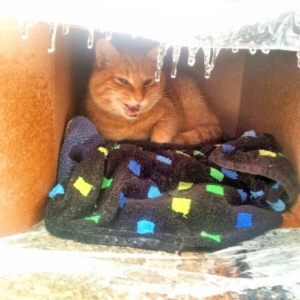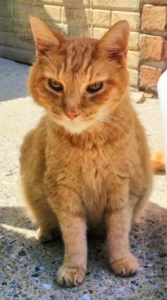The Neighborhood Cat
His name was Garfield. Not because of a love for lasagna, or a penchant for beating up dogs named Odie: Garfield was an orange tabby, and he was a stray.
It was obvious that Garfield was not a feral cat. He would walk right up to you, meowing in his huge voice. He’d rub your legs and want to be petted. He’d fall down at your feet, and expose his belly.
I got to see him a few times a month around the neighborhood. Often, he’d hang out in the shade under a car.
Over time, little details started to emerge about Garfield’s past: As suspected, he’d been someone’s pet. Supposedly, he was turned out onto the streets after he used his human’s car upholstery for a scratching post. When I first got to know him a couple of years ago, he was about seven or eight years old.
Garfield had no place to stay in the winter. When winters were particularly harsh, we made impromptu shelters for him.
A Stray Becomes a Housecat Again – Sort Of
After years fending for himself, Garfield was taken in by one of my neighbors.
It turns out that Garfield was microchipped. When my neighbor took him to the veterinary hospital for a checkup, his previous owners were identified. My neighbor had to contact them to get their permission to give Garfield medical care.
Even though he now had a place to sleep at night, Garfield had gotten used to the life of a stray. He still insisted on being let out during the day, to roam the neighborhood as he’d done for years. When summer came, Garfield was exposed to pretty intense heat. We left out water for him, and he drank cheapest finasteride 5mg greedily.
Garfield’s health was failing. As summer drew to a close, it was obvious that he was starting to lose weight, and his belly was distended. When his condition worsened, my neighbor took him to the vet’s for one final visit.
Stray Thoughts
Garfield was an affectionate cat, and I miss him.
In retrospect, I wish I had called a rescue organization about Garfield.* He might have gotten adopted, and lived a comfortable life with a new family. With years of regular veterinary care, he might still be alive today.
Sadder still were the circumstances that caused Garfield to become a stray in the first place.
I recognize that there are legitimate reasons why a human family can no longer care for a pet. Surrendering a pet is a difficult and complex decision to make. For those considering surrendering their pet, resources such as these can make all the difference.
I would urge anyone in such a situation to rehome their pet humanely. An animal who has lived as a pet, used to regular feedings and indoor shelter, should never just be turned out onto the streets. Such an animal is not equipped for harsher outdoor living conditions.
Many organizations work to find homes for homeless pets. Catering to Cats & Dogs is one of these organizations. There are many more across the country, and worldwide. At the very least, almost every municipality has a local Humane Society—and most offer a sliding scale for surrender fees.
A pet may find the rehoming process temporarily stressful. But it is certainly preferable to abandonment.
*If you see a stray in your neighborhood, you can use Best Friends’ extensive guide to help them find their owners, or find a new home.



